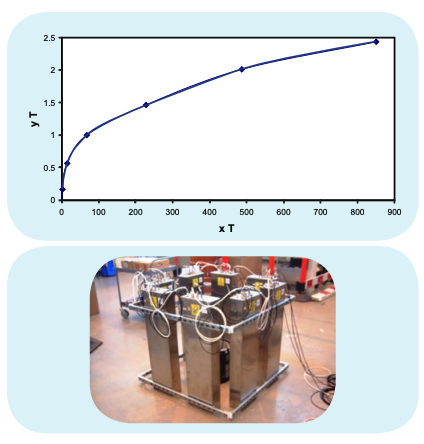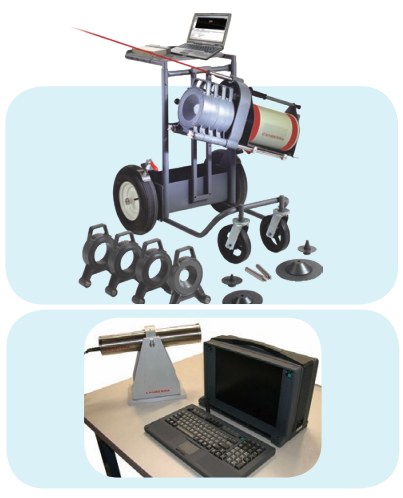Demonstration of box assay for Pu & U inventory
Scope:
This project was undertaken as a demonstration exercise to evaluate the performance of potential Non Destructive Assay equipment and techniques for determining the fissile content of a nominally 3 cubic meter box containing fissile material.
A simulated waste box was constructed, containing unspecified highly heterogeneous wastes and quantities (and isotopic compositions) of Pu and U known only to Sellafield Ltd. The objective of the measurement was to measure the fissile U and Pu content of the box, together with the total measurement uncertainty, so that a robust assessment could be made of the best estimate and an upper fissile mass limit, to provide the data necessary for determining the correct on-site transport and storage route.
This project took place in 2007.

Figure 1. Sample cartogam image showing heterogeneous fissile material distribution.
Key Drivers:
Sellafield Ltd has a number of bulk storage boxes, containing potentially heterogeneous waste matrices and a wide range of unknown Pu and U mass loadings. Furthermore, the isotopic composition is subject to high uncertainties and the quality of the historical records is variable.
The varied physical condition of the containers may lead to a requirement for relocating the boxes to a modern, secure on-site store. However, an essential pre-requisite for such an operation is acquisition of reliable data for the fissile U and Pu content of the boxes, so that compliance with transport regulations and conditions for acceptance at potential storage facilities can be demonstrated.
Sellafield Ltd therefore requested a demonstration project to assess the performance of potential Non Destructive Assay technology.
CANBERRA™ Solution:
Our solution utilized the collective experience within the collective organization, to identify a range of complementary NDA techniques. This approach included both gamma and neutron measurements, in order to deal with every eventually, noting the relative advantages and disadvantages of each physics technique for different types of waste matrix.
We used the following core NDA techniques:
- Passive neutron coincidence counting (PNCC) using an array of N50L neutron counting slabs distributed around the test box, to measure the 240Pu effective mass.
- HRGS gamma spectrometry using a standard ISOCS™ system, to measure the 235U mass and Pu isotopic composition moderating material (HDPE).
- Cartogam gamma imaging to identify areas of concentrated activity and adjust the assumptions made in the analysis for the quantitative fissile assay measurements.
Our analysis also used the following complementary techniques to support the data analysis, assist in development of the system calibrations and evaluating the total measurement uncertainty:
- Scanning “Add-A-Source” matrix compensation to compensate for the effect of the unknown waste matrix and its heterogeneity, on the PNCC measurements and allow an appropriate contribution to the total measurement uncertainty.
- Use of specialist HRGS spectral analysis to measure the activity of isotopes which could potentially interfere with the measured Pu response, including 244Cm which may otherwise lead to gross overestimation of the 240Pu effective mass as measured by PNCC.
- Use of AAS and gamma imaging results to determine the range of effects of the waste matrix and the “as-found” distribution of fissile material within the test box, on the total measurement uncertainty for the final measurement.
Our application of the above techniques was based on the following principles:
- Setup, calibration and operation of systems according to standard procedures.
- Use of computer modeling codes such as MCNP® and ISOCS, according to established “good practice” principles including benchmarking using radioisotope test sources as appropriate (we used a 252Cf neutron source to benchmark our MCNP detection efficiency calibrations and ISOCS measurements with a Pu test source, to benchmark the ISOCS calibration procedure).
- Comparison of results from different techniques, to underpin the assumptions used in the data analysis and refine our total measurement uncertainty assessments.
- Robust assessment and evaluation of total measurement uncertainties.
- Robust documentation of assumptions and limitations associated with our approach.
A team comprising of a CANBERRA spectroscopy specialist and physicist, visited the site and carried out the measurements. Data analysis and reporting was conducted, later, using off-line analysis of the measured spectra and data.
Instruments & Techniques Used:
- Instruments: See Figure 2 and Figure 3.
- Hardware:
- N50L neutron slab counters with JSR-15 shift register data acquisition unit
- Cartogam gamma camera
- ISOCS system (BEGe detector)
- Software:
- Genie™
- MGA
- MCNP
- Techniques:
- Passive neutron coincidence counting (PNCC)
- HRGS gamma spectrometry
- Gamma Imaging
- “Add-A-Source” matrix compensation for neutron measurements
- MCNP modeling for calibration of neutron system

Figure 2. Sample Add-A-Source matrix calibration curve for PNCC measurements and N50L neutron counting modules.

Figure 3. ISOCS and Cartogam Systems.
Achievements
Sellafield Ltd has a number of bulk storage boxes, containing potentially heterogeneous waste matrices and a wide range of unknown Pu and U mass loadings. Furthermore, the isotopic composition is subject to high uncertainties and the quality of the historical records is variable.
The varied physical condition of the containers may lead to a requirement for relocating the boxes to a modern, secure on-site store. However, an essential pre-requisite for such an operation is acquisition of reliable data for the fissile U and Pu content of the boxes, so that compliance with transport regulations and conditions for acceptance at potential storage facilities can be demonstrated.
Sellafield Ltd therefore requested a demonstration project to assess the performance of potential Non Destructive Assay technology.